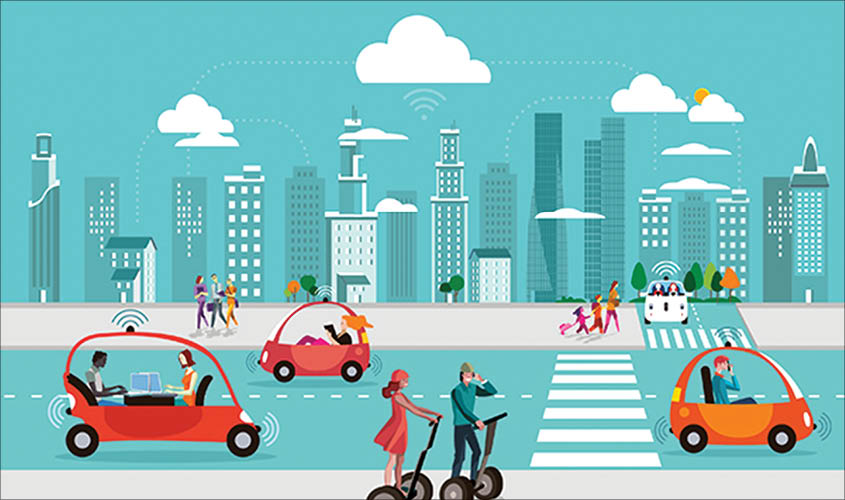A city’s transportation network is its lifeline, and if we want to build smart cities we need to start thinking seriously about smart mobility, which will determine the future of urban development.
Smart mobility basically involves individuals ride-sharing, car-sharing, using public transportation, walking, biking and more, instead of owning a gas-fuelled vehicle. Due to the increasing traffic congestion and the related side effects which include pollution, accidents, and a general waste of time, there is an immediate requirement of smart mobility in almost all cities.
Different governments in different countries have tried to develop solutions to address traffic congestion, yet the number of personal vehicles keeps on rising in urban areas. The expansion in urban zones and the concomitant development suburban areas are mainly to blame for this.
But now, it’s time for a new approach. Rather than analysing how many people move from point A to B and how often they do that, we need to start thinking about the basics of mobility: questions like where do the people come from, where are they heading to, and why are they going there.
Smart mobility is the intelligent integration of shared mobility choices. For example, carpooling, vehicle sharing, bicycle sharing projects and well-developed public transport services. These options are cost-effective for commuters and can substantially contribute in reducing air pollution as well. So it’s the need of the hour that we start looking for ways to shift from our traditional mobility models to a system that is smart and effective.
In addition to that, smart mobility can help us construct sustainable cities with consistent, adaptable and productive development in almost all modes of transport. The idea of smart mobility includes a wide range of methods of transportation: kick bikes, bicycles, light rail trains, trams, streetcars, taxis, self-sufficient vehicles, walking—and the list is growing.
In the past years, a lot of attention has been given to the concept of smart cities. However, there is a lot of ambiguity about what constitutes “smartness” in such urban models. Most people confuse smartness with the use of technology. The reality is that smart development involves putting the available technology to efficient and optimum use in areas of public service. A smart city isn’t built by simply fitting every street corner with state-of-the-art hi-tech systems; it needs to live up to an aesthetic standard, and provide high standards of living. Through many of the surveys done by research agencies in recent years, a majority of people has rated efficient transport system as the topmost requisite in a smart city.
On a holistic approach, a large metropolitan city can have three orbits of road transportation, which are: main routes that use low-floor public transportation; metro feeder routes that don’t provide for any organised form of transport; and last-mile mobility. From these, last-mile transportation is the most chaotic in our country and needs to be fixed urgently.
What we need is an efficiently managed last-mile mode of transport that is easy to use, smart, works on renewable energy and so on. Our cities are already crowded and we do not need hi-speed last mile transportation anymore. What we need is a no-frills, electric/solar-powered mode of transport that moves around slowly in a defined “cell” (a “cell” could be a locality which is connected by metro rail and public buses).
A very thoughtful user-centric design needs to be created which caters to the stereotypes and behavioural patterns of our target audience (mainly seniors, children and the differently-abled). It should move in a designated narrow path and should be constantly on the move. Ideally, it should be an electric vehicle with solar charging and should be able to accommodate at least 8-10 adults.
Last-mile smart vehicles will resolve several problems related to high traffic density, crowded parking spaces and rising pollution. We cannot blindly follow the benchmarks of other countries because Indian demography and behavioural patterns are unique, with very complex population dynamics. With the campaign for building smart cities gaining momentum, this is an ideal time to develop and execute plans for last-mile mobility systems in various cities.
To begin with, a template could be created for a dry run. During the dry run, we should refine the design, plugging all the gaps. After perfecting the system, it could be replicated across the city. One could then adapt this model in other regions, small or big cities, where the 80/20 principle could be followed, with 80% of the design fixed and 20% open for customisation.
With the advent of new transportation technologies, the awareness of smart mobility is at an all-time high.
We now have a range of apps that can help us with public transport, carpooling and other modes to save resources. While these are steps in the right direction, a lot more needs to be done. Improving our transportation networks is the only we can improve our cities.
The author is founder & CEO, Desmania, a Delhi-based product design agency; he can be reached at anuj@desmania.com

